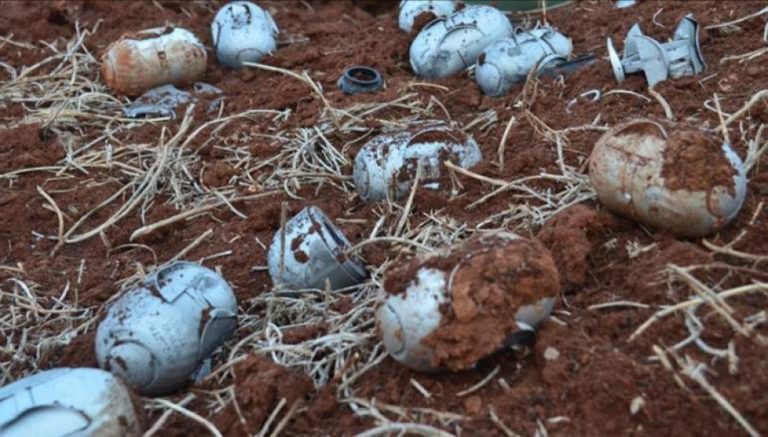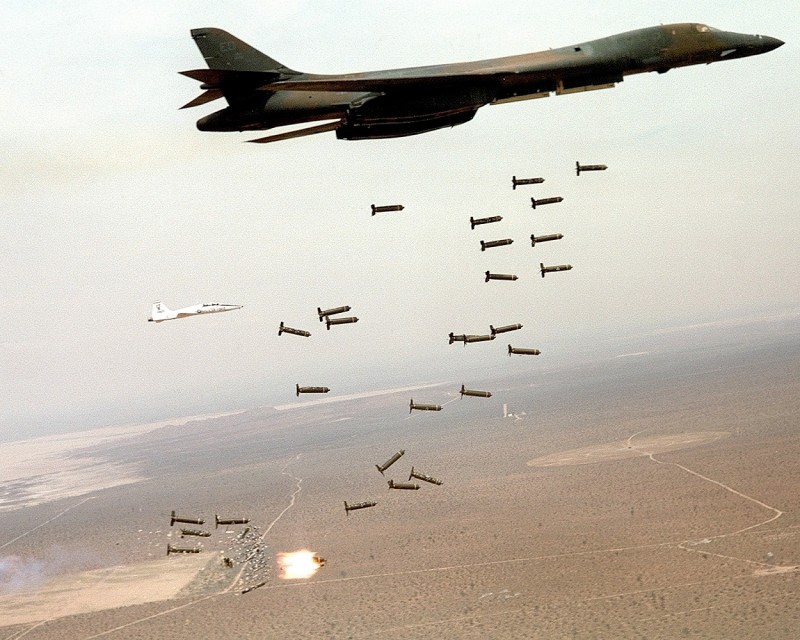
The Multiplying Horror of
Cluster Munitions Use in Ukraine
Richard Krushnic and Jacqueline King / Massachusetts Peace Action
(August 21, 2023) — In a dismaying intensification of the Ukraine war, President Biden announced in early July that the US would begin sending cluster munitions to Ukraine. The decision met with widespread domestic and international opprobrium, including statements against cluster munitions by more than 15 countries and even by outlets that often cheerlead for the US role in the Ukraine War, such as the New York Times.
Cluster bombs are particularly damaging to civilians, because a significant portion of them fail to detonate on impact and are later — sometimes years or decades later — exploded by unsuspecting civilians, especially children.
Biden justified the action by saying the US was running out of conventional 155-millimeter howitzer shells to send to Ukraine and therefore needed to send 155-millimeter artillery shells filled with cluster munitions instead.
These deadly weapons have a range of up to 20 miles. Each shell breaks open midair and releases 72 small grenades (or “bomblets”) meant to explode on impact along the perimeter of an oval-shaped area larger than a football field.
But they don’t always explode, especially when landing on soft soil or in the branches of trees. The percent that fail to detonate immediately are called “duds” and the percentage is known as the “dud rate.” The Pentagon claimed the cluster munitions they were sending had a dud rate of 2.35 percent or less. However, an unknown portion of these munitions include older grenades which, according to the Pentagon’s own statements in a Government Accounting Office paper, actually have a dud rate of 14% or more.
The US is not the only human rights offender in this scenario. In June 2023, Human Rights Watch (HRW) issued a report describing both Russia’s and Ukraine’s use of cluster munitions since February 2022, and even before that, during the civil war beginning in 2014. The report said the Russians have used them more extensively than the Ukrainians — a credible assertion, given that the Russians have far more of all types of munitions and war-fighting equipment than the Ukrainians.
But Human Rights Watch is not a neutral observer; it consistently portrays US foreign policy in a more favorable light than that of other national abusers of human rights. It is not surprising, therefore, that while its report, which came out several weeks before Biden’s announcement, praised NATO countries for not sending cluster munitions, it has since fallen silent about the issue, instead of condemning the US decision to go ahead with the shipments.
The munitions used on both sides have been Soviet-Union-era, and all but one of the 10 types used have been ground-launched via artillery, missiles, or mortars. The Ukrainians began using the munitions within a few days after Biden’s announcement, according to numerous sources, so the shipments to the battlefield had clearly begun beforehand.
By July 23rd, Ukraine was using the new U.S. cluster munitions throughout the 600-mile-long battlefront. They are making a difference in favor of the Ukrainians. In response, the Russians are beginning to use more. If and when the Russians decide to mount a major offensive, it is expected that cluster munitions will play a significant role.
An International Crime
The use of these heinous weapons is a crime, no matter who is wielding them, and should invite the condemnation of all those who care about human rights, whatever their stance on the Ukraine war. Children are especially vulnerable, since they are attracted to the bright-colored, toy-like “duds” (they look like bells with a ribbon handle attached) lying on the ground, and they can be maimed or killed when they try to pick them up and play with them.
The Convention on Cluster Munitions — negotiated in 2008 in response to the “unacceptable harm” caused by these weapons, and joined by 112 States Parties and 12 Signatories — became binding international law when it entered into force on August 1, 2010. It prohibits the use, production, transfer, and stockpiling of cluster munitions. Most NATO states have signed on to the treaty, and have made explicit statements that they will not send them, despite repeated requests from Ukraine. But the US, Russia, and Ukraine have not signed on to this treaty, and continue to send or use the weapons with seeming impunity.
Crocodile Tears
In his announcement, Biden was careful to say that the US would have preferred not to send cluster munitions because of how they can endanger civilians, noting that this painful decision was necessary because the US and NATO allies do not have enough regular shells to send. However, these expressions of humanitarian hesitation and regret are pure theater.
The US is, many times over, the largest user of cluster munitions on the battlefield and. many times over, the largest exporter of such munitions to the world’s militaries. According to the Landmine and Cluster Munition Monitor, the US dropped 413,130 tons of cluster munitions over Vietnam between 1965 and 1973. The Red Cross reported that, in Laos, there are still 80 million US cluster submunitions from the Vietnam War scattered about the country, causing 300 casualties annually.
The Cluster Munitions Coalition (CMC) informs us that the US has not only used cluster munitions in Vietnam, Laos and Cambodia during the Vietnam War; but also in Iraq, Kuwait, Saudi Arabia in 1991; Serbia, Montenegro, and Kosovo in 1999; Afghanistan in 2001-2002; Iraq in 2003; and Yemen in 2009. US-supplied cluster munitions have been used by Israel in Lebanon and Syria, by Morocco in the Western Sahara, by the UK and Netherlands in the former Yugoslavia, and by the UK in Iraq.
So, let us be clear that the US has not before, and does not now, have any humanitarian hesitations regarding the sale or use of cluster bombs at any time it deems such sale or use to be advantageous to the accomplishment of US objectives. Any previous hesitation to provide them to Ukraine could only be due to the fear that the result would be much more widespread use of them in Ukraine by Russia.
What Difference Will They Make?
We are told that the US is sending several hundred thousand cluster shells. So, for a few months, Ukraine will be able to significantly increase its artillery attacks on Russian troops and artillery pieces. But beyond that? The provision of cluster munitions to Ukraine — just as it was becoming more apparent that the much-touted Ukrainian counteroffensive was stalled and was leading to an appalling loss of life and materiél on the battlefield — is one more action the US has taken to prolong and intensify the war.
This grinding war of attrition will not be decided on the battlefield; it can only end at the negotiating table. As Medea Benjamin and Nicolas Davies have pointed out, the US has repeatedly spurned the notion that Ukraine should seek negotiations, whether it was winning or losing at that time on the battlefield, even when cooler heads such as Gen. Mark Milley’s have urged peace talks. Those missed opportunities now mean thousands more Ukrainian and Russian lives lost, and a landscape littered with unexploded ordnance that will endanger civilians for decades to come.
Richard Krushnic is a MAPA researcher and activist. He is working to create a Massachusetts Public Bank, is retired from public financing of community development, and coordinates community development projects in Nicaragua.
Jacqueline King is a MAPA newsletter editor and member of its Board of Directors.
Posted in accordance with Title 17, Section 107, US Code, for noncommercial, educational purposes.


